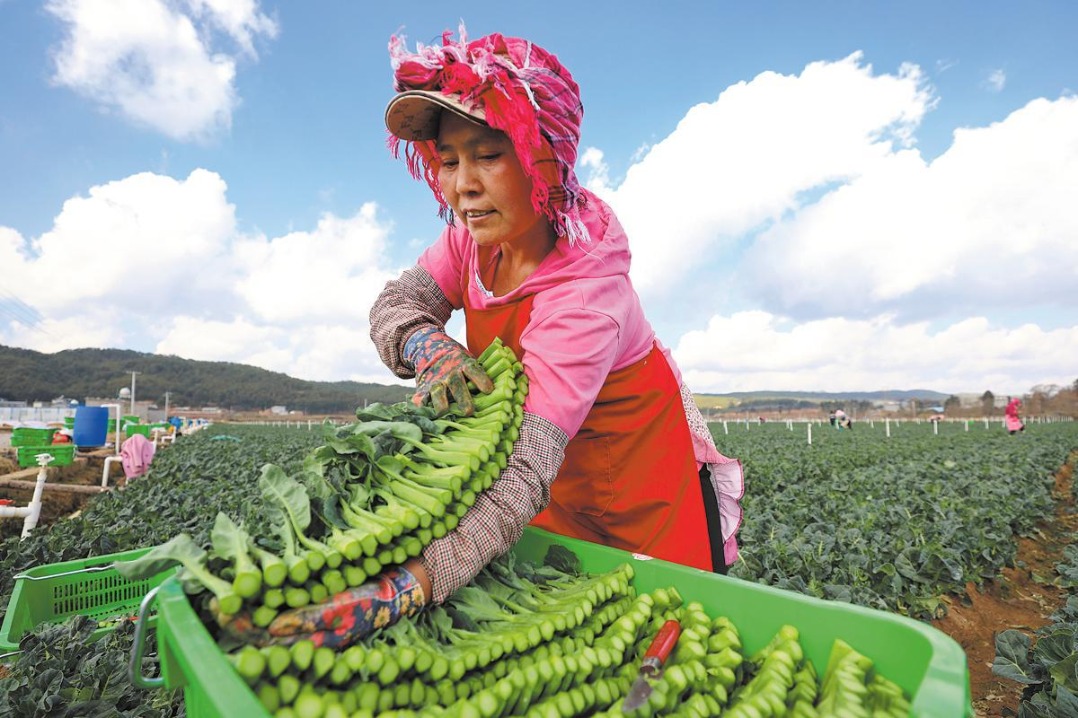Leafing through
Botanist publishes book series on medicinal plants in the country's northeast, Li Yingxue reports.

From a black bear and a wild pig to a viper and a hornet's nest, from landslides and thunderstorms to getting lost and car accidents, Zhou You has encountered various dangers and difficulties during his trips. He describes himself as someone who looks dusty in shabby clothes with a tattered bag containing two cameras. However, when he sees a plant, his eyes light up.
Zhou lives an isolated life each year from April to October. He is never home, either taking photos of plants in the mountains or on his way to find plants. As for the rest of year, he never leaves home, more precisely, his chair, to write down the information about plants that he has gained from his trips for books.
The 60-year-old is a retired professor of the School of Life Science, Tonghua Normal University, in Jilin province. His decades of hard work have recently been published as a book series, Atlas of Medicinal Plant Recourse in the Northeast of China, which contains nine books with 5.5 million words and over 13,000 photos. The full series weighs 25 kilograms.
Collecting over 1,800 wild medicinal plants, the series is dubbed Northeast China's modern version of Bencao Gangmu (Compendium of Materia Medica), an encyclopedic work of medicine and natural history, by Li Shizhen from the Ming Dynasty (1368-1644).
Zhou's interest in plants dates back to his childhood when he saw local barefoot doctors treat patients with herbal medicine, which was simple, convenient and cheap. He chose to study biology in college and started to focus on plant taxonomy.
Zhou's first trip to Changbai Mountain, located in Jilin, was in September 1982. He remembers the mountain for its beautiful and varied terrain. When Zhou started to collect information about plants there in his 20s, he realized that although there were many plant species in the area, the information was incomplete.
"The classification of the medicinal plants on Changbai Mountain was not detailed or accurate. Also, many pictures of the plants were hand-drawn," Zhou says, recalling that he decided to visit the mountain and take photos of the plants and their environment to fill in the missing parts.
Zhou has visited the mountain area more than 160 times. He not only knows how to get to the top of the mountain from any direction but can also tell the name of any plant there. In 2016, Zhou published a book about the plant resources on the mountain.
At the age of 50, Zhou started to explore beyond Changbai Mountain in the country's vast northeastern area. To him, collecting information on the plants with data and words was not enough, the plants needed to be recorded with detailed photos.
Zhou says he lives in a "lucky era" in which he can record with his lens.
"The ancient people could only draw the plants, and in the future, some of the plants may not exist anymore, so I feel the responsibility to record them for future generations," Zhou says.
Taking photos of plants means using proper light so that the features and details of a plant can be clearly seen. For his books, Zhou often took many photos of one plant and selected the best. He took photos from different angles of plants and recorded the growth stages. "I also tried to take photos of all colors of one plant," he says.
Sixty of Zhou's photos have been used as covers in academic journals and over 40 photos have been published by the Chinese National Geography magazine.
Zhou usually has two cameras in his backpack. In the past four decades, seven of Zhou's cameras broke from wear and tear. He says he usually didn't carry much food in his backpack during the field trips, because he wanted his luggage to be light so that he could move more conveniently, and also, he could eat wild fruits on the way.
"I can tell whether a wild fruit is poisonous or not. Also, eating wild plants can help me have a better understanding of the plants," Zhou says.
Losing his way in Changbai Mountain was not a rare experience for Zhou. He says as there are copper and iron mines in the area, sometimes his compass didn't work properly.
"When I get lost, I try to determine the direction of water flow, then I follow it downstream which usually takes me to a road," he says.
Danger was part of Zhou's field trips. He went through seven car accidents, as well as encounters with wild animals. Zhou recalls that on one rainy day, when he woke up in his tent, he found that a viper was coiling on his legs, and he was terrified but stayed still and waited for the snake to leave before he could take a big breath.
Aware of such dangers, Zhou keeps himself safe as best he can. He always keeps three areas of his clothing tight, his collar, wristbands and the legs of his trousers.
In winter, Zhou rejects all social activities and just sits in front of his computer to write. He has collected a huge amount of firsthand information and wanted to write it all down in the form of books. "Also, I had to make sure that my words are beautiful and precise," he says.
Zhou's book on medicinal plants in Northeast China has been published by Heilongjiang Science and Technology Press, after five years of editing, proofreading and designing by over 30 staff members.
According to Xiang Lifu, editor of the book, the company published a book on medicinal plants in Northeast China in 1989.
"It was published in a black-and-white version, with mostly words. Even though it is a bit hard for readers to refer to the book to identify plants in the wild, it has long been sold out as it was useful to people specializing in the field then," Xiang recalls.
Xiang says in his nearly 30 years of editing experience, Zhou's book is the largest project he has worked on, as well as for many of his other colleagues.
"We designed a catalogue for the over 5,000-page book series and made an index based on the Latin name of the plants to make the book more practical for readers," Xiang says.
"The field work was quite arduous," Xiang says, adding that once Zhou got better pictures of the plants included in the book, he would ask the team to replace the photos, even right before the book was to be printed.
All of the over 13,000 photos used in the book series were taken by Zhou, selected from his 350,000 photos.
Xiang says there are around 2,000 medicinal plants in Northeast China, and Zhou's book covers around 95 percent.
Systematically introducing the morphology, distribution and habitats of the medicinal plants in Northeast China, the book series also contains the names, taste and functions of such plants, among other information. Over 5,000 prescriptions are also part of the book series.
The books have been recommended by the Chinese Academy of Sciences academician Sun Handong and academicians of the Chinese Academy of Engineering Zhang Boli and Xiao Peigen.
Sun says the series has important reference value for experts who study medicinal plants in Northeast China and it provides firsthand information for the development, utilization and protection for the plants in the region.
Zhou, who retired this year, is working on his future plan-to visit other parts of the country in the next 15 years and complete a book on wild plants that may have an economic benefit.
Liu Mingtai contributed to this story.







Today's Top News
- Xi addresses Central Urban Work Conference, listing priorities for urban development
- China reports 5.3% GDP growth in H1
- China handles 95 billion parcels in first half of year
- China, India vow to boost relationship
- Tips for expats to strike swifter friendships
- Digital initiative turns city into innovation hub






























